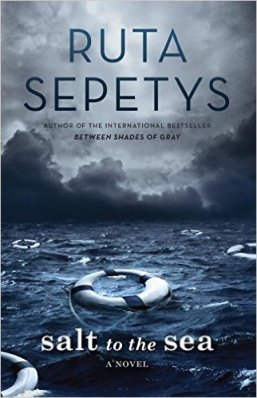What do you know about Lithuania? I certainly didn’t know much before reading Ruta Sepetys’ books. I knew it was one of the Baltic states, taken over by the Soviet Union in the early ye ars of World War II and kept as one of the buffer states during the Cold War. Lithuania became independent in early 1991 — with only short lived interference from the crumbling Soviet Union.
ars of World War II and kept as one of the buffer states during the Cold War. Lithuania became independent in early 1991 — with only short lived interference from the crumbling Soviet Union.
Before reading Sepetys Between Shades of Gray, I knew little about Lithuania. I didn’t give much thought to what Soviet occupation meant. How much brutality lies underneath those few sentences on the subject in a textbook. That anyone seen as part of the intelligentsia, that is, anyone with an education, — teachers, doctors, lawyers, and yes, librarians — all were rounded up and deported. Homes, belongings, possessions lost, families divided. Sepetys draws upon her own family history in her writing, as she is of Lithuanian descent. Fifteen year old Lina narrates the harrowing tale of her families removal, the long journey on the train, work in a labor camp, and final journey to Siberia.
Salt to the Sea reveals another story often hidden from history — the story o f the sinking of the Wilhelm Gustloff, the worst maritime disaster in history. As World War II draws to a close, refugees are fleeing the Baltic States through Poland and Prussia from the advancing Russian army, who pillage everything — that is, everything that the Germans have not destroyed as they are retreating. Refugees, children, soldiers alike seek an escape, a way out. Told from four different narrators whose stories intersect, this is another powerful and eye-opening story from
f the sinking of the Wilhelm Gustloff, the worst maritime disaster in history. As World War II draws to a close, refugees are fleeing the Baltic States through Poland and Prussia from the advancing Russian army, who pillage everything — that is, everything that the Germans have not destroyed as they are retreating. Refugees, children, soldiers alike seek an escape, a way out. Told from four different narrators whose stories intersect, this is another powerful and eye-opening story from
Sepetys.
The links above will take you to Sepetys own site, and I highly recommend listening to her talk about her research and tell the story in her own voice. It also includes more history of the Wilhelm Gustloff, more about displaced persons of the Baltics during the war, and about refugees.
I’ve been thinking about these books quite a lot recently. Lithuania, Estonia and Latvia, joined NATO in 2004. With all the talk of NATO in the recent election cycle, what are the people of the Baltics concerned about these days? It is more important than ever to learn and remember history. In the Author’s Note section of Salt to the Sea, Sepetys writes: “If historical novels stir your interest, pursue the facts, history, memoirs, and personal testimonies, available. These are the shoulders that historical fiction sits upon. When the survivors are gone we must not let the truth disappear with them. Please, give them a voice.”













 I stumbled across an article in the Wall Street Journal today, “
I stumbled across an article in the Wall Street Journal today, “ The Karlson books are available in the US, they are in print, in paperback, so that’s a good sign. I’m ordering them now to share with my younger children. I’m curious about the idea they have been challenged and may do more investigating. One thing that makes me wonder is that Lindgren’s books about Emil are probably equally not widely known and equally, if not more, delightful.
The Karlson books are available in the US, they are in print, in paperback, so that’s a good sign. I’m ordering them now to share with my younger children. I’m curious about the idea they have been challenged and may do more investigating. One thing that makes me wonder is that Lindgren’s books about Emil are probably equally not widely known and equally, if not more, delightful.